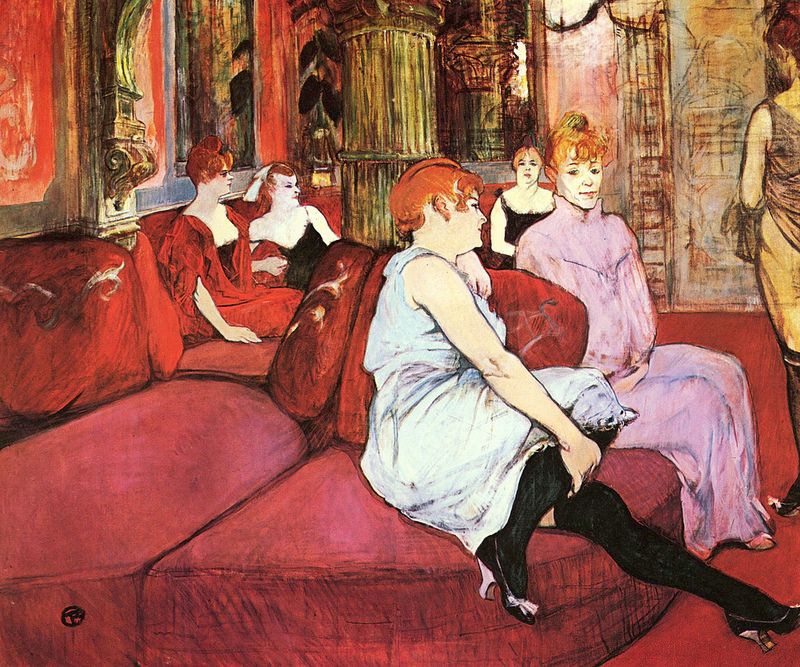Introduction
In the current essay, a painting “Salon de la rue des Moulins” by Henri de Toulouse-Lautrec will be analyzed in-depth, considering the context in which it was created. A brief overview of the painting, the artistic movement, the artist’s style, different influences, and personal reflection on learning will be addressed and discussed. Lautrec painted “Salon de la rue des Moulins” between 1894 and 1895 in Paris, where he lived and worked.
Main body
This painting of Lautrec depicts the daily life of prostitutes in the brothel. Viewers can see six women, five of them are sitting on the red couches, and another one is walking. Lautrec chooses to show in-between moments, while most of the painters tend to portray brothels as places for pleasure and entertainment. At the same time, it is clear that Lautrec does not judge their work but tells about it. Three women sitting behind are dressed and probably waiting to see clients. The two prostitutes in front are dressed in the home clothes, and it seems they are expecting medical checkups, as can be seen from another woman walking into the room with her dress raised.

Lautrec belongs to the Post-Impressionist art movement, and he is one of its most prominent representatives. The main differences from their precursors, Impressionists, were the rejection to depict light and color changes. Lautrec’s style implies oversimplification of forms, sketchy paintings, accent on bright colors, rough and incompleteness of his artworks (Birnholz, 2020). All these characteristics can be seen in “Salon de la rue des Moulins”, where the colors are incredibly intense: many shades of red, black, blue, greenish and yellowish, and ocher. The silhouettes of women are well-defined; however, not all parts of their bodies are precise. He pays attention to their hairstyles and dresses but, in a way, ignores their faces and shapes, as they appear to be very much alike. The strokes are blended, thin, smooth, and flat (Cora, 2020). The overall impression is that Lautrec focuses more on the room interior than on the women that raises many questions of what he aimed to say.
Numerous events influenced Toulouse Lautrec’s work and his artistic style. Two main factors impacted his style: an Impressionist and his colleague Edgar Degas and Japanese woodblock painting (“7 things you didn’t know about Henri Toulouse-Lautrec”, n.d.). Edgar Degas and other Impressionists brought him to their ideas and the way they show life. At the same time, Japanese woodblock prints inspired him to implement the simplicity of forms, bright colors, and flatness into his artworks. Concerning content influences, Lautrec’s lifestyle dictated by his disability was a driving force for his art. The lack of opportunities to spend time as people of his age brought him to society’s margins. He felt comfortable in their company and started portraying them and their lifestyle. As in his picture with prostitutes, it can be seen that he does not judge them but rather understands and recognizes.
Researching Lautrec’s life history helped me understand why he chose to depict marginals, why he paid attention to colors, and what role his disability played in his paintings. I was astonished by the number of the works he made throughout his relatively short life. Even though he became an alcoholic, he created great art regardless of difficult physical and mental health conditions, which makes him incredibly unique.
Conclusion
In conclusion, it should be stated that the painting “Salon de la rue des Moulins” by Toulouse Lautrec was analyzed in detail in the present paper. Moreover, the Post-Impressionistic style of the artist and different kinds of influences, including his disability, Japanese art, and his colleagues’ paintings on his artwork, were addressed. Finally, my personal reflection on the learning for the assignment and its outcomes were provided.
References
Birnholz, A. C. (2020). Henri de Toulouse-Lautrec. Britannica.
Cora, M. (2020). Henri de Toulouse-Lautrec (1864-1901). Heilbrunn Timeline of Art History. Web.
7 things you didn’t know about Henri Toulouse-Lautrec. (n. d.).